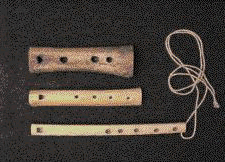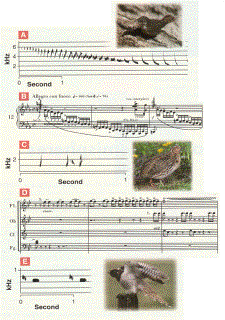|
|
Ancient Instruments
Our Cro-Magnon and Neanderthal ancestors may have been as fond of music as we are. Reconstructions by Jelle Atema of (top) a 53,000-year-old Neanderthal flute made of bear bone, (middle) a 30,000-year-old French deer bone flute, and (bottom) a 4,000-year-old French vulture bone flute.
|
|
 |
|
Avian Composers
Fascinating parallels between bird song and human music, described by Luis Baptista. A spectrogram of a canyon wren's song (A), in which the syllables cascade down the musical scale, compared with (B) a portion of the score of Chopin's "Revolutionary" Etude. (C) A spectrogram of the three note "dactylic" call of the quail. (D) A section of Beethoven's Sixth Symphony illustrating the similarity of the songs of the quail and cuckoo to the refrains of the oboe and clarinet, respectively. (E) A spectrogram of the two-note call of the cuckoo, the first note pitched a major third higher than the second.
figures and text are from:
Patricia M. Gray, B. Krause, J. Atema, R. Payne, C. Krumhansl, L. Baptista (2001) The music of nature and the nature of music. Science, 291, 52-54.
|
|

click for a larger image
|
|
|


